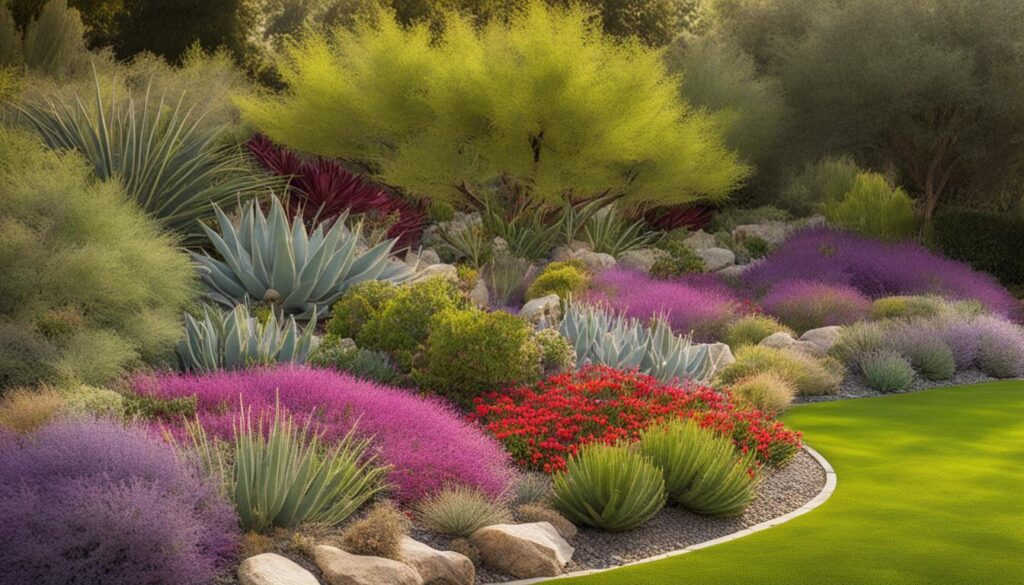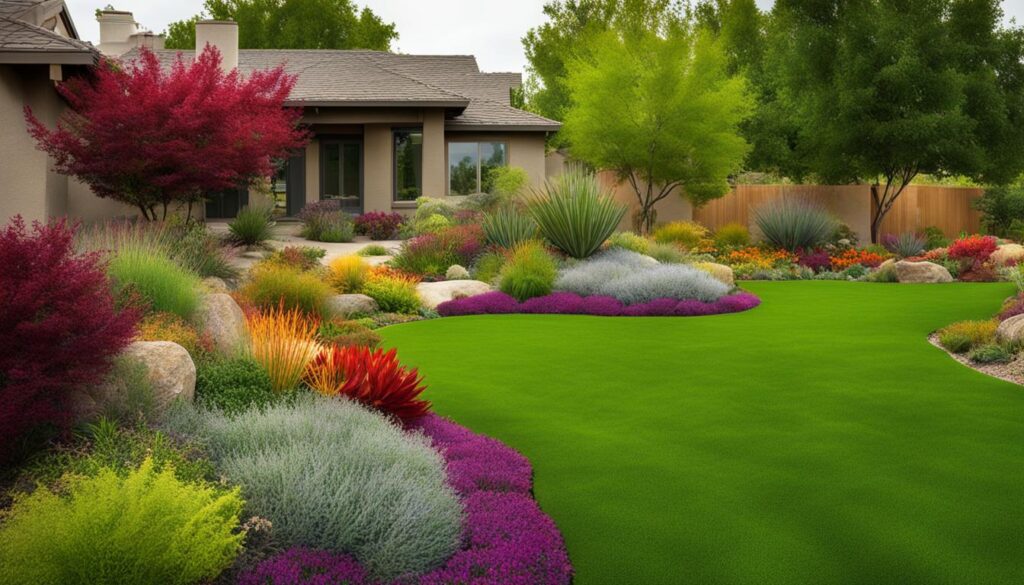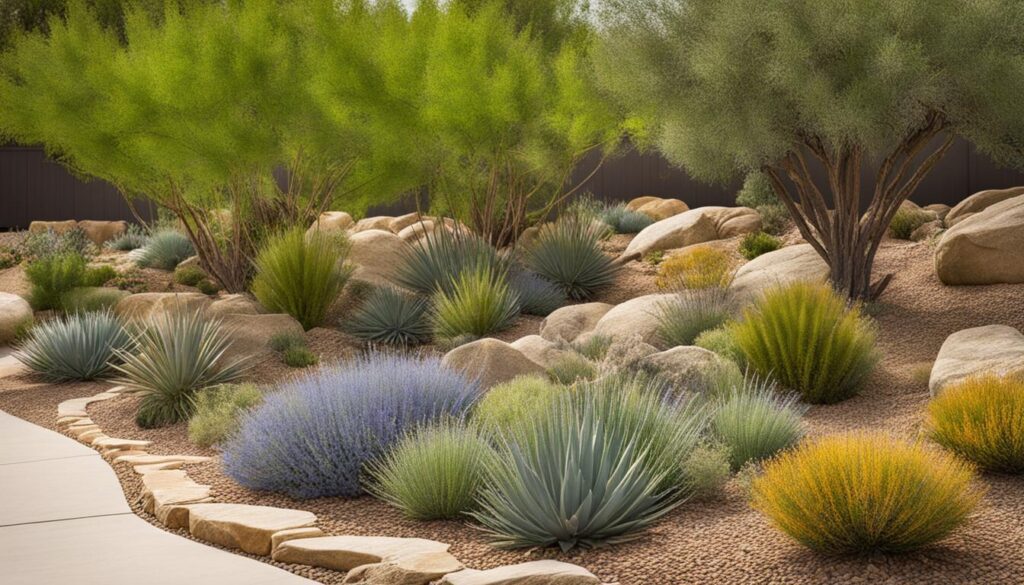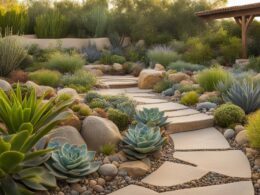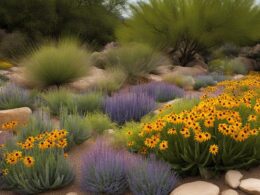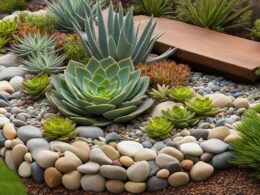Xeriscaping is an increasingly popular low-water gardening technique in the United States, especially in regions like California that face water scarcity. Contrary to popular belief, xeriscaping does not limit you to using only cacti and succulents. There is a wide variety of native trees and shrubs that can thrive in xeriscape gardens while adding color and beauty to the landscape. By incorporating these native plants, you can conserve water, support local ecology, and create a stunning American landscape.
Key Takeaways:
- Xeriscaping is a low-water gardening technique that is gaining popularity in the US.
- Native trees and shrubs can thrive in xeriscape gardens and add color and beauty to the landscape.
- Xeriscaping with native plants helps conserve water and support local ecology.
- Incorporating native trees and shrubs in a xeriscape garden can create a stunning American landscape.
- By following the principles of xeriscaping, you can create a sustainable and water-wise garden.
The Principles of Xeriscaping
Xeriscaping is not just about choosing the right plants for your garden; it’s also about following a set of principles that promote water conservation and create a sustainable environment. By implementing these principles, you can create a beautiful xeriscape garden that requires less maintenance and minimizes water usage. Here are the key principles to keep in mind:
- Planning: Take the time to plan your xeriscape garden before starting. Consider factors such as sun exposure, soil type, and water availability to determine the best layout and plant selection.
- Turfgrass Limitation: Reduce the amount of turfgrass in your xeriscape garden as much as possible. Turfgrass requires regular watering and maintenance, which goes against the concept of water conservation.
- Water-wise Plant Selection: Choose plants that have lower water needs and are well-suited to your local climate. Native plants are often the best choice as they have evolved to thrive in the specific conditions of your region.
- Grouping: Group plants together based on their watering needs. This allows for more efficient irrigation and prevents water waste. Plants with similar water requirements should be planted in the same area.
- Targeted Irrigation: Use targeted irrigation systems, such as drip irrigation or soaker hoses, to deliver water directly to the plants’ root zones. This reduces water evaporation and ensures that plants receive the water they need.
- Mulching: Apply a layer of mulch around plants to conserve moisture and prevent weed growth. Mulch helps to retain soil moisture, reducing the need for frequent watering.
- Maintenance and Pruning: Regularly maintain and prune your xeriscape garden to prevent excessive water needs. Removing dead or overgrown plant material helps to conserve water and promote the health of your plants.
By following these principles, you can create a xeriscape garden that not only saves water but also supports a sustainable environment. Xeriscaping is a practice that benefits both the gardener and the planet, providing a beautiful landscape while conserving water resources.
“Xeriscaping is not just about choosing the right plants for your garden; it’s also about following a set of principles that promote water conservation and create a sustainable environment.”
To illustrate how these principles work in practice, let’s take a look at a sample xeriscape garden layout:
| Plant Type | Water Needs | Irrigation Method | Maintenance |
|---|---|---|---|
| Native Grasses | Low | Drip irrigation | Occasional trimming |
| Shrubs | Moderate | Soaker hoses | Pruning as needed |
| Cacti and Succulents | Minimal | Hand watering | Minimal maintenance |
| Ground Covers | Low | Drip irrigation | Occasional trimming |
This sample layout demonstrates how different plant types can be grouped based on their water needs and irrigated accordingly. By implementing targeted irrigation methods, such as drip irrigation and soaker hoses, water waste is minimized, and each plant receives the appropriate amount of water.
Remember, xeriscaping is all about creating a sustainable garden that conserves water and supports a healthy ecosystem. By following the principles of xeriscaping, you can create a beautiful and environmentally friendly landscape.
Ground Covers and Short Plants for Xeriscaping
When designing your xeriscape garden, incorporating ground covers and short plants can add visual interest and enhance the overall aesthetics of your outdoor space. These plants not only provide color and texture but can also be utilized in various ways, such as at the front of garden beds or as alternatives to traditional lawns. Let’s explore some examples of ground covers and short plants that are suitable for xeriscaping:
Sedum rubrotinctum (‘Pork And Beans’)
This succulent ground cover features fleshy, jelly bean-like leaves that change color from green to red with sun exposure. It is drought-tolerant and requires minimal maintenance.
Pachysandra procumbens (‘Allegheny Spurge’)
This low-growing plant offers dark green, scalloped leaves and delicate white flowers in the spring. It thrives in partial shade and is an excellent choice for woodland xeriscape gardens.
Ophiopogon japonicus (‘Dwarf Lilyturf’)
Also known as mondo grass, this evergreen ground cover forms dense clumps of dark green leaves. It produces small spikes of lavender flowers and is suitable for both sun and shade areas.
Ophiopogon planiscapus (‘Black Mondo Grass’)
This unique ground cover features dark purple, almost black foliage that creates a striking contrast in the garden. It is a low-maintenance plant that can tolerate a wide range of growing conditions.
These are just a few examples of ground covers and short plants that can thrive in xeriscape garden beds. By incorporating these plants into your landscape, you can create a visually appealing and water-efficient outdoor space.
Bedding Plants and Perennials for Xeriscaping
Bedding plants and perennials play a crucial role in adding color and texture to xeriscape gardens. These plants not only enhance the visual appeal of your landscape but also contribute to the overall sustainability of your garden. By carefully selecting the right varieties, you can create a vibrant and water-wise xeriscape garden that thrives in the US climate.
When it comes to xeriscape bedding plants, consider options that are drought-tolerant and low-maintenance. Some popular choices include:
- Sedum: These succulent plants come in a variety of colors and forms, from creeping groundcovers to upright flowering plants. They require minimal watering and add a beautiful texture to your garden.
- Lavender: Known for its aromatic fragrance and beautiful purple flowers, lavender is a versatile plant that thrives in xeriscape gardens. It attracts pollinators and adds a touch of elegance to your landscape.
- Salvia: With its vibrant flowers and attractive foliage, salvia is a stunning addition to any xeriscape garden. It is drought-tolerant and provides nectar for hummingbirds and butterflies.
When choosing xeriscape perennials, opt for plants that are well-suited to your local climate and soil conditions. These plants establish deep root systems, making them more resistant to drought and requiring less water once established. Some popular choices for xeriscape perennials include:
- Penstemon: Also known as beardtongue, penstemon is a beautiful flowering perennial that comes in a variety of colors. It attracts pollinators and is well-adapted to dry conditions.
- Yarrow: Yarrow is a hardy perennial with feathery foliage and clusters of colorful flowers. It is drought-tolerant, attracts beneficial insects, and adds a pop of color to your xeriscape garden.
- Agastache: This aromatic perennial is not only a favorite of bees and butterflies but also thrives in xeriscape gardens. It comes in a range of colors and adds height and structure to your landscape.
By incorporating a variety of xeriscape bedding plants and perennials, you can create a visually stunning and water-efficient garden that thrives year-round. Combine different colors, textures, and heights to create a diverse and dynamic landscape that is both attractive and environmentally conscious.
Xeric and Native Perennials for Xeriscaping
When it comes to xeriscaping, choosing water-smart plants that are adapted to local conditions is key. Xeric and native perennials are excellent options for creating a beautiful and sustainable xeriscape garden in the US. These plants have evolved to thrive in specific regions, making them more drought-tolerant and resilient. Incorporating xeric and native perennials not only conserves water but also supports the local ecosystem.
Some popular choices for xeric and native perennials include early-blooming bulbs, columbine, amsonia, windflower, pasque flower, chocolate flower, poppy mallow, asclepias, eriogonum, penstemon, oenothera, helianthus, winecups, and hyssop. These plants come in a variety of colors, shapes, and sizes, allowing you to create a diverse and visually appealing xeriscape garden.
One of the advantages of using xeric and native perennials is their low maintenance requirements. Once established, they require less water and care compared to non-native plants. This not only saves you time and effort but also reduces the need for excessive watering, contributing to water conservation efforts in your area.
Advantages of Xeric and Native Perennials:
- Adapted to local conditions and climate
- Drought-tolerant and resilient
- Support local ecology
- Low maintenance once established
- Water-smart choices
By incorporating xeric and native perennials into your xeriscape garden, you can create a vibrant and sustainable landscape. These plants not only add beauty and color but also help conserve water and support the local ecosystem. Consider the unique benefits of xeric and native perennials when planning your xeriscape design.
Trees and Shrubs for Xeriscaping
When it comes to xeriscaping, incorporating native trees and shrubs is an excellent way to add shade, structure, and beauty to your garden while conserving water. Native plants are well-adapted to the local climate and soil conditions, making them more resilient and water-wise choices. Here are some examples of trees and shrubs that are suitable for xeriscaping:
| Tree | Water Requirements | Height | Special Features |
|---|---|---|---|
| Serviceberry | Low to moderate | 10-25 ft | Edible fruits, attractive fall foliage |
| Fremont Mahonia | Low to moderate | 2-8 ft | Evergreen, yellow flowers, blue berries |
| American Plum | Low to moderate | 15-25 ft | Edible fruits, showy white flowers |
| Buffaloberry | Low | 6-12 ft | Edible fruits, silver-gray foliage |
These plants not only provide beauty and structure to your xeriscape garden but also support local ecology by attracting native wildlife such as birds and butterflies. Remember to choose plants that are appropriate for your specific region and consider factors such as sunlight exposure and soil type when selecting trees and shrubs for your xeriscape garden.
Incorporating native trees and shrubs into your xeriscape garden can create a beautiful, sustainable landscape that requires less water and maintenance. By choosing water-wise plants and following the principles of xeriscaping, you can have a thriving garden while conserving water and supporting local ecology. So, get started on your xeriscape journey and enjoy the benefits of a water-smart and environmentally-friendly garden.
Turf and Alternatives in Xeriscaping
If you’re looking to incorporate xeriscaping into your garden, it’s important to consider turf alternatives that can help you conserve water and create a sustainable landscape. Traditional lawns can be water-intensive, requiring regular watering and maintenance. By replacing part or all of your turfgrass with water-conserving options, you can reduce your water usage while still enjoying a beautiful and functional outdoor space.
Here are some popular turf alternatives for xeriscaping:
- Pavers: Pavers are a great option for creating pathways, patios, and other hardscape features in your xeriscape garden. They come in a variety of materials, colors, and patterns, allowing you to customize the look of your outdoor space.
- Gravel: Gravel is a low-maintenance option that can add texture and visual interest to your xeriscape garden. It allows water to penetrate the soil more easily and helps with drainage.
- Rocks: Rocks are another popular choice for xeriscape gardens. They can be used to create borders, rock gardens, or even as focal points in your landscape design. Rocks also retain heat, helping to warm the soil and promote plant growth.
In addition to these alternatives, you can also incorporate soil amendments to improve water retention in your garden. This can help reduce the need for excessive watering and ensure that your plants have access to the moisture they need.
| Turf Alternatives | Water Conservation Benefits | Visual Appeal |
|---|---|---|
| Pavers | Reduce water usage and allow for better drainage | Customizable options for various design styles |
| Gravel | Improves soil permeability and water penetration | Textural contrast and low-maintenance option |
| Rocks | Retain heat, warm the soil, and support plant growth | Natural elements that add visual interest |
By choosing xeriscape turf alternatives, you can create a water-conserving garden that not only reduces your environmental impact but also provides a visually appealing outdoor space. Whether you opt for pavers, gravel, rocks, or a combination of these alternatives, your xeriscape garden will thrive while minimizing water usage and maintenance requirements.
Conclusion
Xeriscaping with native trees and shrubs brings a multitude of benefits to your landscape. Not only does it conserve water, but it also supports the local ecology and creates a stunning, sustainable environment. By following the principles of xeriscaping and embracing xeriscape ideas, you can achieve a beautiful garden that thrives in the US climate while minimizing water usage and maintenance requirements.
By incorporating appropriate ground covers, short plants, bedding plants, perennials, trees, and shrubs, you can create a diverse and visually appealing xeriscape garden. Additionally, choosing water-wise alternatives to traditional turfgrass, such as pavers, gravel, and rocks, can further reduce water consumption and add natural beauty to your landscape.
With xeriscaping, you have the opportunity to create a unique and water-smart garden that not only enhances the aesthetic appeal of your property but also contributes to the conservation of this valuable resource. So, why not embrace xeriscaping and transform your American landscape into a sustainable oasis?






